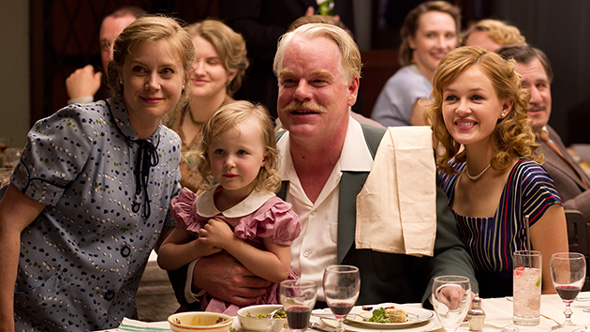Curious about the deliverables for The Master, which hit theaters earlier this month in 70mm, 35mm, and 4K DCP formats? So was I. I asked FotoKem, which provided large-format and finishing services for the film, to fill in some of the details.
Many cinephiles were excited when word got out that director Paul Thomas Anderson (Boogie Nights, There Will Be Blood) was shooting part of his new feature film in 65mm, yielding an image that should far outstrip standard 35mm film in quality. It felt like something of a resurrection for 70mm, which hasn't been used as an origination format for a narrative feature film in more than a decade. Buzz built as fans tried to sort out which theaters in which markets would receive coveted 70mm prints. According to a 9/18 update at Cigarettes & Red Vines, "the definitive Paul Thomas Anderson resource," a total of 16 70mm prints of the film were struck for worlwide distribution.
The existence of a 70mm version of the film raised an obvious question about the provenance of those prints: were they old-school film prints, created with photochemical intermediates rather than the now-standard digital-intermediate process? The answer, it turns out, is an unqualified yes. FotoKem said earlier this week that the 35mm shots — only about 25 percent of the film — were assembled and answer-printed, then blown up to a 65mm dupe negative, which was intercut with native 65mm footage in a complete negative cut of the film that was used to make 70mm release prints. Meanwhile, the 65mm material was transferred to a 35mm reduction negative, which was intercut with the original 35mm negative for production of 35mm prints. So a limited number of prints in both 35mm and 70mm formats were finished completely photochemically.
But that's not the end of the story. A small number of 35mm prints were produced from cut negative, but not enough for the wide release. The majority of 35mm prints were filmed out as part of the same DI process that created the 4K digital cinema master. The source material for that DI was timed intermediate 65mm film elements scanned at 8K and 35mm original negative scanned at 6K, according to Andrew Oran, FotoKem's VP of large-format and restoration services.
That means that P.T. Anderson completists have four different versions of The Master to contend with before it finishes its run in movie theaters. First, there are the 70mm prints, which were all made in a photochemical finishing process. Second are the limited number of 35mm prints also struck from cut negative. (FotoKem doesn't know where those ended up.) Third are the general-release 35mm prints made from a hybrid 8K/6K DI process, and the fourth option is the 4K DCP, from the same DI, which will be projected at different resolutions depending on the capabilities of individual theaters.
| The Master release format | Source for 65mm component | Source for 35mm component |
| 70mm film prints | 65mm film negative | 65mm dupe negative (blowup) |
| 35mm film prints (photochemical) | 35mm reduction negative | 35mm film negative |
| 35mm film prints (from DI) | 8K scans of film elements | 6K scans of film elements |
| 4K DCP | 8K scans of film elements | 6K scans of film elements |
And it's not hyperbole to suggest that there are some viewers trying to keep track of these differences. Some movie buffs say there are tiny flecks of dirt visible in digital presentations of the film that don't seem to be present when 70mm prints are projected. A DI based on 8K scans of a 65mm interpositive and 6K scans of 35mm negative sounds pretty impressive to me, so I asked Oran if — disregarding other qualitative differences in the image — a DI made using an 8K scan might actually reveal detail in the film frame that's obscured in the process of making a 70mm release print. Here's his response:
It would be interesting to do side by side testing of a 70mm print of a high-resolution focus chart vs. digital files produced by scans of that same chart to investigate the issue raised here about on screen resolution of 4K DCP’s vs. 70mm prints. Short of that sort of objective testing, it’s hard to answer this question. There are lots of variables: compression of the DCP, focus/lens of both projection devices, steadiness of the digital projector vs. potential jitter of the film, etc. And none of that gets at the “feel” of each, which is a more purely subjective matter. That having been said, the 4K DCP from 8K scans does retain an enormous amount of the source detail of the 65mm negative.
That's a very diplomatic answer that boils down to "Maybe." Well, I'll take it. In the right hands, film can look great. And as anyone who's seen a too-dim multiplex DCP can attest, poorly handled digital can look lousy. The best thing about seeing The Master in 70mm or The Dark Knight Rises in 15-perf/70mm IMAX is that it reminds everyone what film can do, technically, and it pushes the industry to remain absolutely on top of its game as we continue to finesse the digital transition.
Did you enjoy this article? Sign up to receive the StudioDaily Fix eletter containing the latest stories, including news, videos, interviews, reviews and more.


Imax ix not 5 perf verticle It is 15 perf horizontal
Yes. D’oh. Fixed.